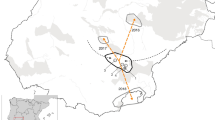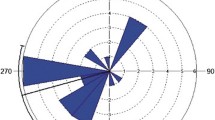Abstract
Reintroductions have been increasingly used in carnivore conservation. Animal movement influences fitness and survival and is the first behavioural response of reintroduced animals to ‘forced dispersal’ in a new habitat. However, information available on early post-release movement of reintroduced carnivores remains limited. We studied movements of 11 reintroduced lions (Panthera leo) in Dinokeng Game Reserve, South Africa, in their first season of release and investigated changes in movements over time. Movement patterns of lions were more diverse than expected and varied between sexes and individual groups. Some lion groups returned to the area surrounding the release site after initial exploration and avoided human settlements, suggesting that vegetation and human disturbances influenced dispersal upon release. Cumulative home range size continued to increase for all lions despite individual differences in movement patterns. We highlight the importance of considering the variation in individual-specific behaviour and movement patterns to assess early establishment and reintroduction success.






Similar content being viewed by others
References
Armstrong DP, Seddon PJ (2008) Directions in reintroduction biology. Trends Ecol Evol 23(1):20–25
Bélisle M (2005) Measuring landscape connectivity: the challenge of behavioural landscape ecology. Ecology 86(8):1988–1995
Benard MF, McCauley SJ (2008) Integrating across life-history stages: consequences of natal habitat effects on dispersal. Am Nat 171(5):553–567
Berger-Tal O, Saltz D (2014) Using the movement patterns of reintroduced animals to improve reintroduction success. Curr Zool 60(4):515–526
Beyer HL (2004) Hawth’s analysis tools for ArcGIS. Version 3.27. http://www.spatialecology.com/htools/ Accessed Jul 2011
Bonte D, Dyck HV, Bullock JM et al (2012) Costs of dispersal. Biol Rev 87:290–312
Bowler DE, Benton TG (2005) Causes and consequences of animal dispersal strategies: relating individual behaviour to spatial dynamics. Biol Rev 80(2):205–225
Calenge C (2006) The package adehabitat for the R software: a tool for the analysis of space and habitat use by animals. Ecol Model 197:516–519
Cardillo M, Purvis A, Sechrest W, Gittleman JL, Bielby J, Mace GM (2004) Human population density and extinction risk in the world’s carnivores. PLoS Biol 2(7), e197. doi:10.1371/journal.pbio.0020197
de Boer WF, Vis MJP, De Knegt HJ et al (2010) Spatial distribution of lion kills determined by the water dependency of prey species. J Mammal 91(5):1280–1286
de Hoog (2014) Habitat selection of African elephants (Loxodonta africana) after reintroduction in Dinokeng Game Reserve. MSc thesis, University of the Witwatersrand, South Africa
Debeffe L, Morellet N, Cargnelutti B, Lourtet B, Coulon A, Gaillard JM, Bon R, Hewison AJM (2013) Exploration as a key component of natal dispersal: dispersers explore more than philopatric individuals in roe deer. Anim Behav 86:143–151
Delgado MM, Penteriani V, Nams VO, Campioni L (2009) Changes of movement patterns from early dispersal to settlement. Behav Ecol Sociobiol 64:35–43
Druce D, Genis H, Braak J, Greatwood S, Delsink A, Kettles R, Hunter L, Slotow R (2004) Population demography and spatial ecology of a reintroduced lion population in the Greater Makalali Conservancy, South Africa. Koedoe 47(1):103–118
Ferreira SM, Hofmeyr M (2013) Managing charismatic carnivores in small areas: large felids in South Africa. S Afr J Wildl Res 44(1):32–42
Fortin D, Beyer HL, Boyce MS, Smith DW, Duchesne T, Mao JS (2005) Wolves influence elk movements: behaviour shapes a trophic cascade in Yellowstone National Park. Ecology 86:1320–1330
Funston PJ, Mills MGL, Richardson PRK, van Jaarsveld AS (2003) Reduced dispersal and opportunistic territory acquisition in male lions (Panthera leo). J Zool 259:131–142
Getz WM, Wilmers CC (2004) A local nearest-neighbor convex-hull construction of home ranges and utilization distributions. Ecography 27:489–505
Google Earth 6.0 (2005). Accessed Jul 2013
Hawkes C (2009) Linking movement behaviour, dispersal and population processes: is individual variation a key? J Anim Ecol 78:894–906
Hayward MW, Hayward GJ (2006) Activity patterns of reintroduced lion Panthera leo and spotted hyaena Crocuta crocuta in the Addo Elephant National Pak, South Africa. Afr J Ecol 45(2):135–141
Hayward MW, Slowtow R (2009) Temporal partitioning of activity in large African carnivores, tests of multiple hypotheses. S Afr J Wildl Res 39(2):109–125
Hayward MW, Somers MJ (eds) (2009) Reintroduction of top-order predators. Blackwell Publishing, West Sussex
Hayward MW, Adendorff J, O’Brien J et al (2007a) The reintroduction of large carnivores to the Eastern Cape, South Africa: an assessment. Oryx 41(2):205–214
Hayward MW, Adendorff J, O’Brien J et al (2007b) Practical considerations for the reintroduction of large, terrestrial, mammalian predators based on reintroductions to South Africa’s Eastern Cape Province. Open Conserv Biol J 1:1–11. doi:10.2174/1874-8392/07
Hayward MW, Hayward GJ, Druce DJ, Kerley GIH (2009) Do fences constrain predator movements on an evolutionary scale? Home range, food intake and movement patterns of large predators reintroduced to Addo Elephant National Park, South Africa. Biodivers Conserv 18:887–904
Herfindal I, Linnell JDC, Odden J, Nilsen EB, Andersen R (2005) Prey density, environmental productivity and home-range size in the Eurasian lynx (Lynx lynx). J Zool 265(1):63–71
Hunter LTB (1998) The behavioural ecology of reintroduced lions and cheetahs in the Phinda Resource Reserve, Kwazulu-Natal, South Africa. PhD thesis, University of Pretoria, South Africa
Hunter LTB, Pretorius K, Carlisle LC, Rickelton M, Walker C, Slotow R, Skinner JD (2007) Restoring lions Panthera leo to northern KwaZulu-Natal, South Africa: short-term biological and technical success but equivocal long-term conservation. Oryx 41(2):196–204
IUCN (1998) Guidelines for re-introductions. Prepared by the IUCN/SSC Re-introduction Specialist Group. IUCN, Gland
Kerley LL, Goodrich JM, Miquelle DG, Smirnov EN, Quigley HB, Hornocker MG (2002) Effects of roads and human disturbances on Amur tigers. Conserv Biol 16(1):97–108
Kilian PJ (2003) The ecology of reintroduced lions on the Welgeconden Private Game Reserve, Waterberg. MSc thesis, University of Pretoria, South Africa
Kruskal WH, Wallis WA (1952) Use of ranks in one-criterion variance analysis. J Am Stat Assoc 47:583–621
Linnell JDC, Odden J, Smith ME (1997) Translocation of carnivores as a method for managing problem animals: a review. Biodivers Conserv 6:1245–1257
Lund U, Agostinelli C (2014) CircStats: Circular Statistics, from “Topics in circular Statistics” (2001). R package version 0.2-4. http://CRAN.R-project.org/package=CircStats
Miller SM, Funston P (2014) Rapid growth rates of lion (Panthera leo) populations in small, fenced reserves in South Africa: a management dilemma. S Afr J Wildl Res 44(1):43–55
Miller B, Ralls K, Reading RP, Scott JM, Estes J (1999) Biological and technical considerations of carnivore translocation: a review. Anim Conserv 2(1):59–68
Miller SM, Blssett C, Burger A et al (2013) Management of reintroduced lions in small, fenced reserves in South Africa: an assessment and guidelines. S Afr J Wildl Res 43(2):138–154
Morales JM, Moorcroft PR, Matthiopoulos J, Frair JL, Kie JG, Powell RA, Merrill EH, Haydon DT (2010) Building the bridge between animal movement and population dynamics. Philos Trans R Soc Lond B 365:2289–2301
Mucina L, Rutherford MC (eds) (2006) The vegetation of South Africa, Lesotho and Swaziland. Strelitzia 19, South African National Biodiversity Institute, Pretoria
New M, Lister D, Hulme M, Makin I (2002) A high-resolution data set of surface climate over global land areas. Clim Res 21:1–25
Ngoprasert D, Lynam AJ, Gale GA (2007) Human disturbance affects habitat use and behaviour of Asiatic leopard Panthera pardus in Kaeng Krachan National Park, Thailand. Oryx 41(3):343–351
Preatoni D, Mustoni A, Martinoli A et al (2005) Conservation of brown bear in the Alps: space use and settlement behavior of reintroduced bears. Acta Oecol 28:189–197
R Core Team (2015) R: A language and environment for statistical computing. R Foundation for Statistical Computing, Vienna, Austria. ISBN 3-900051-07-0, URL http://www.R-project.org/
Rogers LL (1988) Homing tendencies of large mammals: a review. In: Nielsen L, Brown RD (eds) Translocation of wild animals. Wisconsin Humane Society, Wisconsin, pp 76–92
Roshier DA, Doerr VAJ, Doerr ED (2008) Animal movement in dynamic landscapes: interaction between behavioural strategies and resource distributions. Oecologia 156(2):465–477
Santini L, Marco MD, Visconti P, Baisero D, Boitani L, Rondinini C (2013) Ecological correlates of dispersal distance in terrestrial mammals. Hystrix 24(2):181–186
Seddon PJ, Armstrong DP, Maloney RF (2007) Developing the science of reintroduction biology. Conserv Biol 21(2):303–312
Spinola RM, Serfass TL, Brooks RP (2008) Survival and post-release movements of river otters translocated to western New York. Northeast Nat 15(1):13–24
Spong G (2002) Space use of lions, Panthera leo, in the Selous Game Reserve: social and ecological factors. Behav Ecol Sociobiol 52:303–307
Stamps JA, Swaisgood RR (2007) Someplace like home: experience, habitat selection and conservation biology. Appl Anim Behav Sci 102:392–409
Stamps JA, Krishnan VV, Willits NH (2009) How different types of natal experience affect habitat preferences. Am Nat 174(5):623–630
Tambling CJ, Cameron EZ, Du Toit JT, Getz WM (2010) Methods for locating African lion kills using global positioning system movement data. J Wildl Manag 73(3):549–556
Tilman D, Kareiva P (eds) (1997) Spatial ecology: the role of space in population dynamics and interspecific interactions. Princeton University Press, New Jersey
Vanthomme H, Kolowski J, Korte L, Alonso A (2013) Distribution of a community of mammals in relation to roads and other human disturbances in Gabon, Central Africa. Conserv Biol 27(2):281–291
Wilmers CC, Wang Y, Nickel B, Houghtaling et al (2013) Scale dependent behavioral responses to human development by a large predator, the puma. PLoS ONE 8(4), e60590
Woodroffe R (2000) Predators and people: using human densities to interpret declines of large carnivores. Anim Conserv 3(2):165–173
Zar JH (1984) Biostatistical analysis. Prentice-Hall, New Jersey
Acknowledgments
The research was supported by The Rufford Foundation and The University of Hong Kong Postgraduate Research Travel Award. We wish to thank the Dinokeng Management Association for the permission to conduct the research and provision of satellite collars. We thank Kwalata Game Ranch, Mongena Game Lodge, Pride of Africa, Paradise Link, iKhaya LamaDube Game Lodge and landowners for their assistance in the field and for allowing the fieldwork to be undertaken in their properties. We thank Trevor Keith and Charl Pretorius for their invaluable support throughout.
Author information
Authors and Affiliations
Corresponding author
Rights and permissions
About this article
Cite this article
Yiu, SW., Keith, M., Karczmarski, L. et al. Early post-release movement of reintroduced lions (Panthera leo) in Dinokeng Game Reserve, Gauteng, South Africa. Eur J Wildl Res 61, 861–870 (2015). https://doi.org/10.1007/s10344-015-0962-0
Received:
Revised:
Accepted:
Published:
Issue Date:
DOI: https://doi.org/10.1007/s10344-015-0962-0




